Before you Begin
This tutorial shows you how to add data labels to your map visualization in Oracle Analytics.
Background
You can visualize data on maps with different backgrounds and data layers. In this tutorial, you learn how to display labels for the data points on your map. You create a dataset that contains latitude and longitude data elements and transform these data elements to use with the Latitude and Longitude data layer available in Oracle Analytics. You also implement property changes to learn how to customize your map visualization.
What Do You Need?
- Access to Oracle Analytics
- Download donation.xlsx to your computer
Create a Dataset
In this section, you create a dataset from the spreadsheet file that you downloaded to your computer.
- Sign in to Oracle Analytics.
- On the Home page, click Create and click Dataset.
- In Create Dataset, click Drop data file here or click to browse.
- In File Upload, click the donation.xlsx file and click Open.
- In Create Dataset Table from donation.xlsx, click OK.
- In the Join Diagram, click Measure
 in the SCH_LATITUDE column and select Attribute.
in the SCH_LATITUDE column and select Attribute. - In the Join Diagram, click Measure
 in the SCH_LONGITUDE column and select Attribute.
in the SCH_LONGITUDE column and select Attribute.
Associate the Latitude and Longitude Columns with a Map Layer
In this section, you convert the SCH_LATITUDE and SCH_LONGITUDE columns to text attributes and associate the columns with a map layer.
- Click the donation tab.
- In the SCH_LATITUDE column, click Options
 and select Location Details.
and select Location Details. - In Location Details SCH_LATITUDE, select Latitude from Location Type and click OK.
The data element symbol changes from A, for attribute, to use the Location
 icon indicating the the column is associated with a map layer.
icon indicating the the column is associated with a map layer.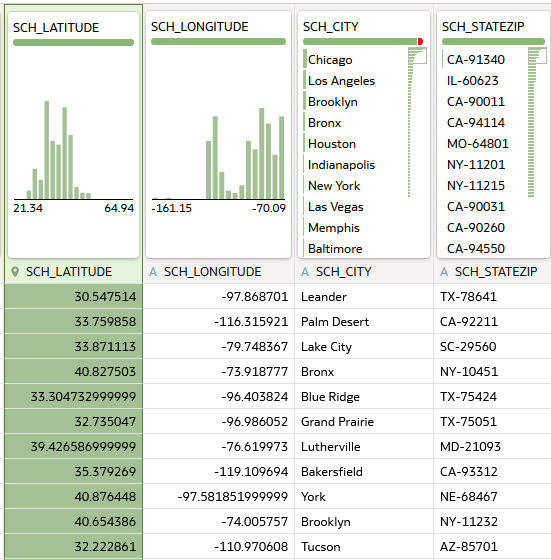
Description of the illustration latitude_map_layer.png - In the SCH_LONGITUDE column, click Options
 and select Location Details.
and select Location Details. - In Location Details LONGITUDE, select Longitude from Location Type and click OK.
- Click Save
 . In Save Dataset As, enter
. In Save Dataset As, enter school_donationsand click OK.
Create a Map Visualization
In this section, you create a map visualization. You also change the map background and the colors used for the data points.
- Click Create Workbook.
- In the Data pane under the school_donations dataset, hold-down the Ctrl key, select SCH_LATITUDE, SCH_LONGITUDE, and NUM_DONORS. Drag the data elements to the canvas.
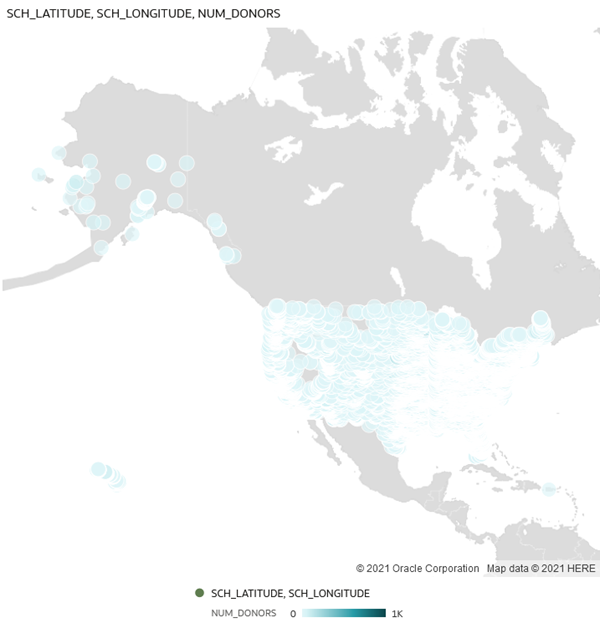
Description of the illustration num_donors_original.png - Click Properties
 . In Properties, click Map
. In Properties, click Map  .
. - In the Zoom Control row, click Off to add the magnification controls to the map visualization.
The Zoom Control value is On when the magnification controls are enabled.
- In the Background Map row, click Default (Oracle BI) and select Oracle Maps.
- In the map visualization, click Menu
 , select Color, and then select Manage Assignments. In Manage Color Assignments, click Presets
, select Color, and then select Manage Assignments. In Manage Color Assignments, click Presets  , select Viridis, and then click Done.
, select Viridis, and then click Done.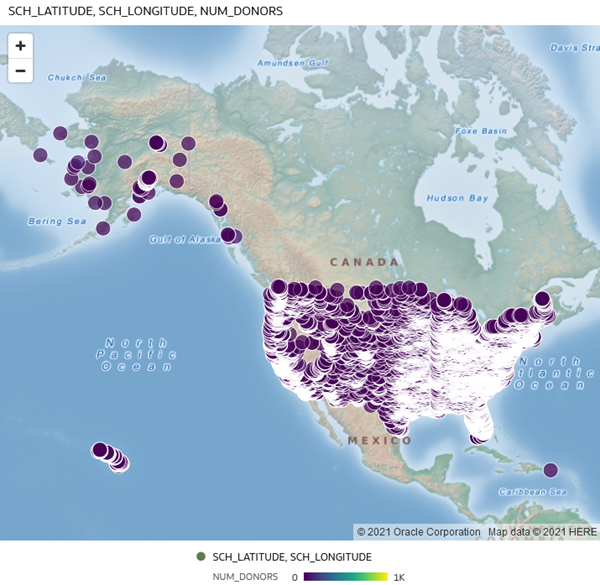
Description of the illustration updated_map_vis.png
Add Data Labels
In this section, you select the data element to use for the label, modify the font size, and select the label's location relative to the data point. Because the sample data contains a lot of data points, the tutorial is using an area of the map with the least data points, the State of Alaska.
- In the map visualization, click the Rectangular selection
 tool, drag the cursor across the Alaska data points and release to make the selection.
tool, drag the cursor across the Alaska data points and release to make the selection. - Click the visualization Menu
 and select Keep Selected.
and select Keep Selected.
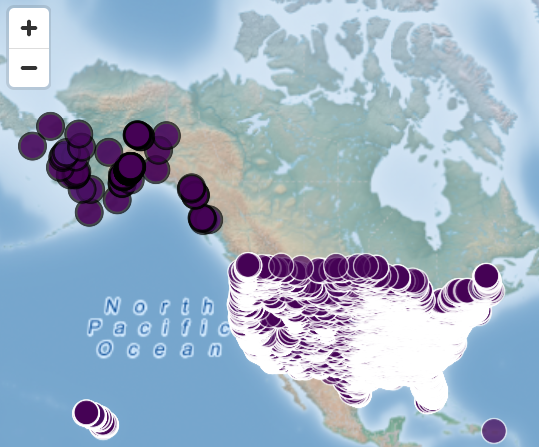
Description of the illustration alaska_data_points.png - Click Zoom in
 control to get a closer view of an area in Alaska with the most data points. Adjust the magnification to reduce the overlapping data points.
control to get a closer view of an area in Alaska with the most data points. Adjust the magnification to reduce the overlapping data points.
The largest concentration of data points is around Anchorage, Alaska.

Description of the illustration anchorage_data_points.png - In Properties
 , click Data Layers
, click Data Layers  .
. - In Data Layers, click Off in the Data Labels Position row and select Above.
- In the Columns row, click SCH_LATITUDE. Click NUM_DONORS to use as the data point label. Remove the checks from SCH_LATITUDE and SCH_LONGITUDE.
- In the Font row, click Auto. Select 18 from the font size list.
- Click the Zoom in
 control to view the number of donors where the data points overlap.
control to view the number of donors where the data points overlap.
You can control the level of magnification to see the details provided by the data labels.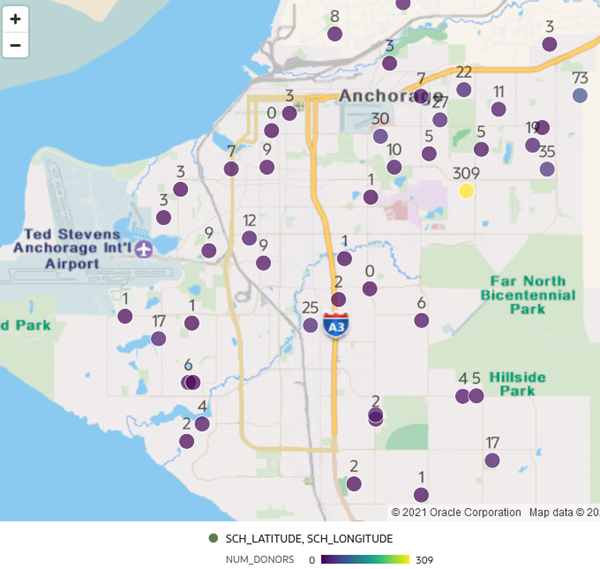
Description of the illustration num_donors_label.png
Create a Map Visualization with Different Data
In this section, you duplicate the map visualization and select a different data element to use as the map's data point.
- In the map visualization, click Menu
 , select Edit, and then select Duplicate Visualization.
, select Edit, and then select Duplicate Visualization. - In the Data pane, select TOTAL_DONATIONS and drag it to Color to replace NUM_DONORS.
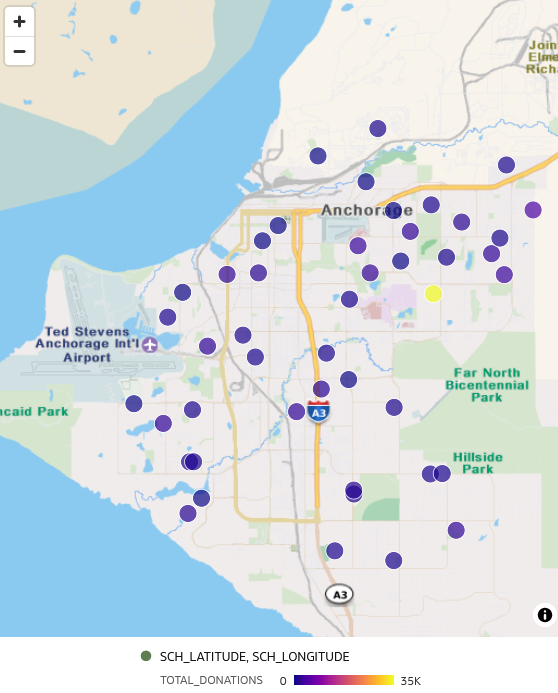
Description of the illustration total_donations.png - Click Properties
 . In Properties, click Data Layers
. In Properties, click Data Layers  .
. - In the Columns row, click None and click TOTAL_DONATIONS.
- In the Font row, click Auto 18, enter
14to make more room for the data point value. - In the Size row, click 18, and enter
10to reduce the size of the data points.You can see the differences in the font and data point sizes in the map visualizations.

Description of the illustration donors_donations.png
Learn More
Add Data Labels to Map Visualizations in Oracle Analytics
F85268-02
July 2024
Learn how to label data points on map visualizations in Oracle Analytics.
This software and related documentation are provided under a license agreement containing restrictions on use and disclosure and are protected by intellectual property laws. Except as expressly permitted in your license agreement or allowed by law, you may not use, copy, reproduce, translate, broadcast, modify, license, transmit, distribute, exhibit, perform, publish, or display any part, in any form, or by any means. Reverse engineering, disassembly, or decompilation of this software, unless required by law for interoperability, is prohibited.
If this is software or related documentation that is delivered to the U.S. Government or anyone licensing it on behalf of the U.S. Government, then the following notice is applicable:
U.S. GOVERNMENT END USERS: Oracle programs (including any operating system, integrated software, any programs embedded, installed or activated on delivered hardware, and modifications of such programs) and Oracle computer documentation or other Oracle data delivered to or accessed by U.S. Government end users are "commercial computer software" or "commercial computer software documentation" pursuant to the applicable Federal Acquisition Regulation and agency-specific supplemental regulations. As such, the use, reproduction, duplication, release, display, disclosure, modification, preparation of derivative works, and/or adaptation of i) Oracle programs (including any operating system, integrated software, any programs embedded, installed or activated on delivered hardware, and modifications of such programs), ii) Oracle computer documentation and/or iii) other Oracle data, is subject to the rights and limitations specified in the license contained in the applicable contract. The terms governing the U.S. Government's use of Oracle cloud services are defined by the applicable contract for such services. No other rights are granted to the U.S. Government.
This software or hardware is developed for general use in a variety of information management applications. It is not developed or intended for use in any inherently dangerous applications, including applications that may create a risk of personal injury. If you use this software or hardware in dangerous applications, then you shall be responsible to take all appropriate fail-safe, backup, redundancy, and other measures to ensure its safe use. Oracle Corporation and its affiliates disclaim any liability for any damages caused by use of this software or hardware in dangerous applications.
Oracle and Java are registered trademarks of Oracle and/or its affiliates. Other names may be trademarks of their respective owners.
Intel and Intel Inside are trademarks or registered trademarks of Intel Corporation. All SPARC trademarks are used under license and are trademarks or registered trademarks of SPARC International, Inc. AMD, Epyc, and the AMD logo are trademarks or registered trademarks of Advanced Micro Devices. UNIX is a registered trademark of The Open Group.
This software or hardware and documentation may provide access to or information about content, products, and services from third parties. Oracle Corporation and its affiliates are not responsible for and expressly disclaim all warranties of any kind with respect to third-party content, products, and services unless otherwise set forth in an applicable agreement between you and Oracle. Oracle Corporation and its affiliates will not be responsible for any loss, costs, or damages incurred due to your access to or use of third-party content, products, or services, except as set forth in an applicable agreement between you and Oracle.